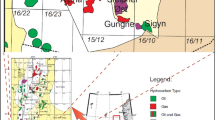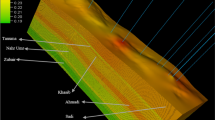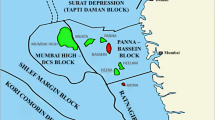Abstract
Mechanical earth model is a numerical representation of the stress state, pore pressure and rock mechanical properties. While the different parameters in the MEM are interconnected in various ways, they fundamentally stem from the same basic set of log measurements. This paper demonstrates a scientific workflow to build a comprehensive well-centric MEM for a well in a carbonate reservoir in Persian Gulf and calibrate it via utilizing the existing data including LOT, MDT, drilling incidents, etc., to minimize the uncertainties related to data limitations. Finally, the calibrated MEM was used for sensitivity analysis of various wellbore trajectories and mud weight/pressure window for planning future wells and safe drilling in this underdevelopment field. Poroelastic modeling along with rigorous calibration indicates strike slip toward normal faulting stress regime. Also, shear wave anisotropy analysis results in N40E orientation for the maximum horizontal stress. The optimum mud weight for safe drilling was found to be 120 pcf for Gachsaran Formation, 105 pcf for all the formations from Asmari to Kazhdumi limestone and 85 pcf for all the formations from Yamama to total depth. On this basis, it is recommended to put the casing shoes at the base of Gachsaran, Kazhdumi limestone and final depth. The results recommend planning the future wells horizontally in the NE–SW direction for formations having SS stress regime and wells near vertically in formations having NF stress regime. Besides, the drilling safe mud window resulting from Mogi–Coulomb failure criterion is broader, while the Mohr–Coulomb is more limited.








Similar content being viewed by others
References
Zhang L, Cao P, Radha K (2010) Evaluation of rock strength criteria for wellbore stability analysis. Int J Rock Mech Min Sci 47(8):1304–1316
Karakus M, Perez S (2014) Acoustic emission analysis for rock–bit interactions in impregnated diamond core drilling. Int J Rock Mech Min Sci 68:36–43
Khosravanian R, Aadnoy BS (2016) Optimization of casing string placement in the presence of geological uncertainty in oil wells: offshore oilfield case studies. J Petrol Sci Eng 142:141–151
Boutt D, Cook B, Williams J (2011) A coupled fluid–solid model for problems in geomechanics: application to sand production. Int J Numer Anal Methods Geomech 35(9):997–1018
Sayers CM, Schutjens PMTM (2007) Introduction to geomechanics. Lead Edge 26(5):582–583
Goodman HE, Connolly P (2007) Reconciling subsurface uncertainty with the appropriate well design using the mechanical earth model (MEM) approach. Lead Edge 26:585–588
Wang H, Sweatman R, Engelman B, Deeg W, Whitfill D, Soliman M, Towler BF (2008) Best practice in understanding and managing lost circulation challenges. J SPE Drill Complet 23(2):168–175
Plumb R, Edwards S, Pidcock G, Lee D, Stacey B (2000) The mechanical earth model concept and its application to high-risk well construction projects. In: IADC/SPE 59128 drilling conference, New Orleans, Louisiana, USA
Elyasi A, Goshtasbi K, Naeimipour A (2013) Numerical assessment of the mechanical stability in vertical, directional and horizontal wellbores. Int J Min Sci Technol 23:937–942
Zhou D, Zheng P, He P, Peng J (2016) Hydraulic fracture propagation direction during volume fracturing in unconventional reservoirs. J Petrol Sci Eng 141:82–89
Halliburton (2016) Reduce non-productive time (NPT). http://www.halliburton.com/en-US/ps/solutions/deepwater/challenges-solutions/reduce-non-productive-time.page?node-id=hgjyd452&Topic=DeepwaterWestAfrica. Checked on 11/18/2016
Schlumberger (2016) Real-time drilling geomechanics. http://www.slb.com/~/media/Files/dcs/product_sheets/geomechanics/geomechanics_rt_ps.pdf. Checked on 11/18/2016
Wiprut D, Zoback M (2000) Constraining the stress tensor in the Visund field, Norwegian North Sea: application to wellbore stability and sand production. Int J Rock Mech Min Sci 37:317–336
Chang C, Zoback MD, Khaksar A (2006) Empirical relations between rock strength and physical properties in sedimentary rocks. J Pet Sci Eng 51(3–4):223–237
Zhang J, Lang J, Standifird W (2009) Stress, porosity, and failure-dependent compressional and shear velocity ratio and its application to wellbore stability. J Pet Sci Eng 69(3/4):193–202
Charlez PS, Onaisi A (2001) Wellbore stability: one of the most important engineering challenges when drilling smart wells in interactive drilling for fast track oilfield development. In: Lecourtier J (ed) TECHNIP, pp 77–102
Maleki S, Gholami R, Rasouli V, Moradzadeh A, Ghvami R, Sadeghzadeh F (2014) Comparison of different failure criteria in prediction of safe mud weigh window in drilling practice. Earth Sci 136:36–58
Rajabi M, Tingay M, Heidbach O, Hillis R, Reynolds S (2017) The present-day stress field of Australia. Earth Sci Rev 168:165–189
Chardac O, Murray D, Carnegie A, Marsden R (2005) A proposed data acquisition program for successful geomechanics projects, SPE 93182
Ali AHA, Brown T, Delgado R, Lee D, Plumb D, Smirnov N, Marsden R, Prado-Velarde E, Ramsey L, Spooner D (2003) Watching rocks change-mechanical earth modeling. Oilfield Rev 15(1):22–39
Fjaer E, Holt RM, Horsrud P, Raaen AM, Risnes R (2008) Petroleum related rock mechanics, 2nd edn. Elsevier, Amsterdam
Ameen MS, Smart BGD, Somerville JMC, Hammilton S, Naji NA (2009) Predicting rock mechanical properties of carbonates from wireline logs (a case study: Arab-D reservoir, Ghawar field, Saudi Arabia). Mar Pet Geol 26(4):430–444
Wang Z (2001) Dynamic versus static elastic properties of reservoir rocks. In: Wang Z, Nur A (eds) Seismic and acoustic velocities in reservoir rocks, vol 3, pp 531–539 ibUnstructured>
Militzer H, Stoll R (1973) Einige Beitraege der Geophysik zur primaerdatenerfassung im Bergbau. Neue Bergbautechnik, Leipzig 3(1):21–25
Gholami R, Moradzadeh A, Rasouli V, Hanachi J (2014) Practical application of failure criteria in determining safe mud weight windows in drilling operations. J Rock Mech Geotech Eng 6:13–25
Zhang J (2011) Pore pressure prediction from well logs: methods, modifications, and new approaches. Earth Sci Rev 108:50–63
Eaton BA (1975) The equation for geopressure prediction from well logs. Society of Petroleum 748 Engineers of AIME, paper SPE 5544
Hottmann C, Johnson R (1965) Estimation of formation pressures from log-derived shale properties. J Petrol Technol 17(6):717–722
Matthews W, Kelly J (1967) How to predict formation pressure and fracture gradient. Oil Gas J 65(8):92–106
Gardner GHF, Gardner LW, Gregory AR (1974) Formation velocity and density-the diagnostic basics for stratigraphic traps. Geophysics 39:770–780
Bowers GL (1995) Pore pressure estimation from velocity data: accounting for overpressure mechanisms besides under compaction. SPE Drill Complet 10(2):89–95
Zang A, Stephansson O (2010) Stress field of the earth’s crust. Springer, Amsterdam
Ostadhassan M, Zeng Z, Zamiran S (2012) Geomechanical modeling of an anisotropic formation-Bakken case study. In: 46th US Rock mechanics/geomechanics symposium. American Rock Mechanics Association
Kidambi T, Kumar GS (2016) Mechanical Earth Modeling for a vertical well drilled in a naturally fractured tight carbonate gas reservoir in the Persian Gulf. J Petrol Sci Eng 141:38–51
Acknowledgements
The author expresses his gratitude to National Iranian Oil Company (NIOC) for sharing their practical data with me during the course of this research.
Author information
Authors and Affiliations
Corresponding author
Ethics declarations
Conflict of interests
The authors have no conflicts of interest to declare that are relevant to the content of this article.
Ethical approval
All procedures performed in studies involving human participants were in accordance with the ethical standards of the institutional and/or national research committee and with the 1964 Helsinki declaration and its later amendments or comparable ethical standards.
Informed consent
Informed consent was obtained from all individual participants included in the study.
Rights and permissions
About this article
Cite this article
Noohnejad, A., Ahangari, K. & Goshtasbi, K. Comprehensive mechanical earth modeling using well data. Innov. Infrastruct. Solut. 6, 9 (2021). https://doi.org/10.1007/s41062-020-00369-w
Received:
Accepted:
Published:
DOI: https://doi.org/10.1007/s41062-020-00369-w




